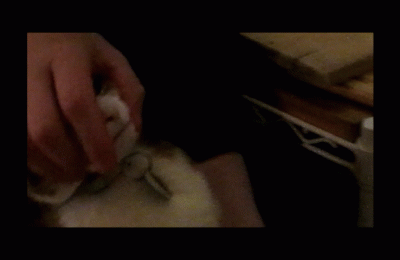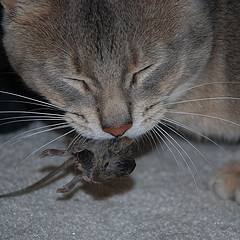Animal cognition incorporates several aspects of animal thinking: memory, concept formation, learning ability, and reasoning – such as problem solving. Every species has different “problems” to solve throughout their evolutionary history – which may make them good or bad at certain types of tasks. This does not, however, mean that any one aspect of cognition is a good measure of intelligence, because again, every species has an area of specialty. Squirrels are good at finding nuts they buried to eat later, cats are excellent at hunting mice and birds…and I am not good at either of those things!
Because cats work for their food (via hunting), we might expect them to excel at tasks that test their ability to acquire food via different means. Although my own research found that cats preferred to eat freely available food over that available in a food puzzle, most of the cats were successful at using the food puzzle (they just didn’t prefer it!). A new study out of the University of Detroit Mercy in Michigan (Effects of Socialization on Problem Solving in Domestic Cats) looked at cats’ ability to acquire food from a puzzle feeder. But the researchers were interested in more than just whether the cat could get the treats – they also wanted to know whether the cats’ level of socialization (how comfortable they are with humans) impacted their performance when problem-solving to get food. Previous research has suggested that sociability with humans and captive living results in better cognitive performance in some non-human animals. Let’s take a closer look at what the researchers did to assess cats’ abilities!
How the researchers studied problem-solving in cats
The researchers worked with 86 cats (40 male, 46 female, aged between 1 and 10 years) housed at a shelter in Chattanooga, TN. Some cats in the study were tested by shelter staff, using the shelter’s Feline Behavior Assessment, which is a modified version of the ASPCA’s Feline Spectrum Assessment (FSA). The test measures things such as a cat’s response to approach by a human, whether the cat responds to an offered hand with approach, and how the cat responds to touch. Cats were assessed based on “distance-reducing” behaviors (meaning the cat was approaching with friendly body language) and behaviors that indicate the cat is well-socialized (such as rolling and yawning). Higher scores indicate a higher level of socialization.

Each cat was tested using a puzzle box that was built for the study. The transparent box had airholes so that cats could see and smell the treats inside. A plastic tab separated the top half of the box from the bottom half. If the cats pulled the tab with their teeth or paws, the treat would fall to the bottom where the cat could access it.
Cats had access to the puzzle box for up to 10 minutes (or less if they solved the puzzle in less than 10 minutes). The cat watched the researcher place the treat in the box, and then was left alone for the duration of the session. Cameras were set up to record the cat’s interactions with the puzzle box while the scientist was out of the room, watching remotely on an iPad. After each session, the researchers returned and if the cat did not solve the puzzle, they were given the treat at that time (hey, A for effort!).
The researchers measured:
- When did the cats first touch the puzzle box?
- Did the cats successfully get the treat from the puzzle box?
- If the cats did solve the puzzle, how long did it take?
What did the cats in the study do?
Twenty-four out of 86 cats (around 28%) of cats successfully extracted the treat from the puzzle box. Age had an effect on solving the puzzle – such that younger cats were more likely to get the treat out of the box on their own than older cats. Socialization also had an effect: cats with higher socialization scores were more likely to solve the problem! Cats with higher socialization scores were also faster to solve the problem than cats with lower scores. The more social cats tended to be faster to touch the puzzle box, but it was not a statistically significant effect.
What do the findings mean about cats?
In this study, the more social cats were more likely to solve the puzzle box and solve it faster. They were more willing to approach and interact with the puzzle box, making it more likely that they could solve the problem. Like in other species, interactions with humans may be helpful to cats when solving a problem (especially an “artificial” one such as interacting with a human-made device).
Another consideration is the effect of domestication on cognition and the brain. Domestication has resulted in cats with slightly smaller brains than their closest relatives. – and this effect is found in several species, including dogs, pigs, sheep and cows. However, domestication may also result in some benefits.
Animals can be neophobic (fearful of novel objects) or neophilic (willing to interact with novel objects). Although wild animals must encounter novelty in their daily lives, depending on how closely they live to humans, they may have more or less experience with human-made objects. Socialization to humans may help cats be less neophobic, which has been found to correlate with problem-solving in other species, such as orangutans and vervet monkeys (and problem-solving is typically measured using puzzle feeders and other human-made devices).
Despite the positive effects of being young and social, only 28% of cats were able to solve the problem. Why so few? Perhaps the puzzle box was too challenging, and 10 minutes was just not enough time for cats to interact with it. The cats in the study were not food-deprived (as is often the case with some animal research) so their food motivation may have varied (note: this is not an argument for food deprivation!). As in my study of contrafreeloading (the willingness of animals to work for food) – it is possible that these kitties just didn’t feel like exerting themselves for those treats.

A shelter is a stressful environment, and it’s also possible that the cats would have benefited from being tested in a happy and safe home environment. It’s also possible that the study was affected by the measure of socialization used. However, it’s not especially surprising that cats who are more comfortable around humans would perform better on the task, given that even if the humans stepped away during the session, they still had to set up the equipment, which might have been stressful to some cats.
Regardless, this is a lovely small study that utilized an alternative to doing laboratory research and where the cats were volunteers…and 72% said they couldn’t be bothered!
Foerder, P. & Howard, M.C. (2024). Effects of Socialization on Problem Solving in Domestic Cats. Animals, 14, 2604. https://doi.org/10.3390/ani14172604



